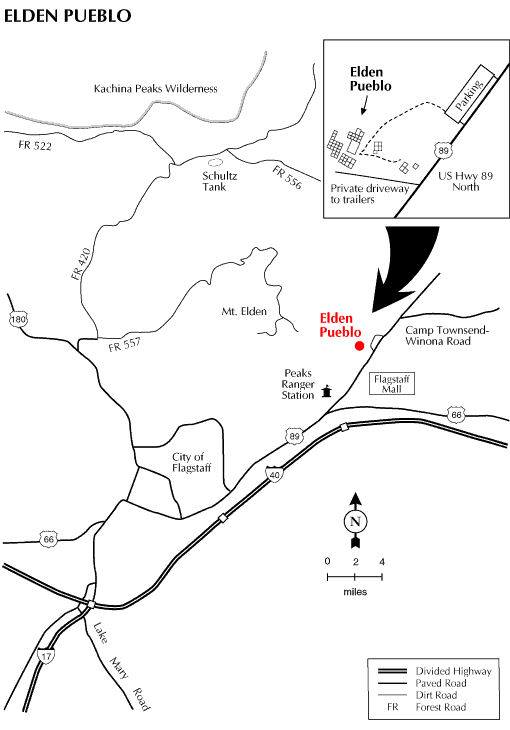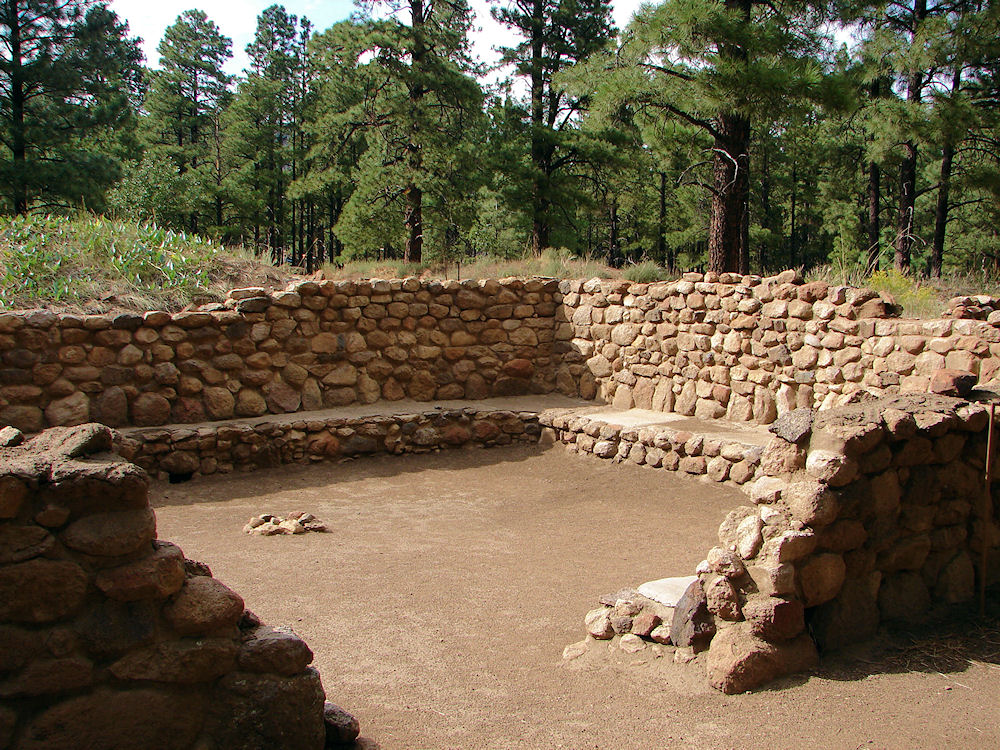Elden Pueblo
Ancient Sinagua Ruins
Flagstaff, Arizona
Travels & Tours
Pictures, Photos, Images, & Reviews.
George and Eve DeLange
September 01, 2009

Google Map To Elden Pueblo, Sinagua Ruins, Flafstaff, Arizona.
September 01, 2009

Google Map To Elden Pueblo, Sinagua Ruins, Flafstaff, Arizona.
View Larger Map

 |
| U.S. Forest Service Coconino National Forest Map To Elden Pueblo. Ancient Sinagua, Ruins, Flagstaff, Arizona. |
|---|
 |
| Elden Pueblo Ancient Sinagua, Ruins, Flagstaff, Arizona. Coconino National Forest. |
|---|
 |
| Elden Pueblo Ancient Sinagua, Ruins, Flagstaff, Arizona. Coconino National Forest. |
Click On Any Of The Following Links By Amazon.Com
For Books, & Videos About About Arizona Native American Ruins. No Obligation!
Elden Pueblo of downtown Flagstaff, Arizona. In the Coconino National Forest. just off of Interstate 40. Elden Pueblo is the site of an ancient Sinagua (Sin ah� wa) village, which was inhabited from about A.D. 1,070 to 1,275. A Google Earth Map search marks Elden Pueblo at about: 35o 14' 36.79" N 111o 34' 04.71" W. It is at about 6,945 feet elevation.
The Sinagua: The Sinagua are the best known regional group that anthropologists refer to as the Western Anasazi. The Sinagua occupied an area between Flagstaff and Phoenix, Arizona, including the Verde Valley and significant portions of the Mogollon Rim country, between about 500 and about 1,425 AD. They led a simple life based on corn farming and subsistence hunting and gathering at the periphery of the three major Southwest cultures. After volcanic activity improved soil conditions around 1,000 AD, the Sinagua began to thrive by assimilating various elements from the major cultural groups. From the Hohokam they acquired village life and the use of ball courts; from the Anasazi they adopted cliff dwellings and water conservation practices; from the Mogollon they adopted pottery styles. By the late 1,450s, the same natural and social stresses that destroyed the other cultures of the region engulfed the Sinagua as well. By about 1,425, they had completely disappeared. But, their dwellings and religious shrines can be found all over Central Arizona. One is even located in a city park in the city of Phoenix! The early Sinagua sites consist of pit houses. Their later structures more closely resembled the pueblo architecture found in other cultures throughout the southwestern United States. The name Sinagua was given to this culture by archaeologist Harold Colton, founder of the Museum of Northern Arizona. Sinagua is derived from the Spanish words "sin" meaning "without" and "agua" meaning "water", referring to the name "Sierra Sin Agua" which was originally given by the Spanish explorers to the San Francisco Peaks near Flagstaff, Arizona. Colton also distinguished between two different Sinagua cultures. The Northern Sinagua were clustered around the Flagstaff area, with Elden Pueblo, Walnut Canyon National Monument, Wupatki National Monument, being the best-known publicly-accessible sites. The Southern Sinagua were found throughout the Verde Valley of Central Arizona. Most notable sites open to the public being; Montezuma's Castle, Montezuma's Well, Tuzigoot National Monument, the Palatki Archaeological Site, and the V-Bar-V Petroglyph Site. The last known recording of Sinagua occupations for any of the Sinagua sites are of those in Montezuma Castle National Monument in about 1,425 AD. The reasons for the abandonment of their habitation sites are not yet known; but warfare, drought, and clashes with the newly-arrived Yavapai people are possible suggestions. Several of the Hopi clans trace their roots to immigrants from the Sinagua culture. The Hopi clans believe their ancestors left the Verde Valley for religious reasons. Elden Pueblo is known to the modern day Hopi as a spititual ancestral place thay call Pasiove or Pavasioki. Elden Pueblo & The Sinagua: Archaeologists are fairly sure that the Sinagua of Elden Pueblo were skilled farmers that planted, cultivated, and harvested corn, beans, and squash that were the staple agriculture products of these people. They also collected wild plants, and berries to add to their diet. In addition they hunted the local wild game. It is also known that the distant tribes from other regions as far away as California and Mexico, would trek along the trading routes to trade with the Sinagua. Some items found at the site are: macaw skeletons from as far south as Mexico, to shell jewelry from California. Evidence suggests that they traded for salt, pottery, cotton, seashells and some semi-precious stones in exchange for their agriculture and hunting goods. Elden Pueblo Today: In 1916 during a vacation to Flagstaff, Dr. and Mrs. Harold S. Colton was first named Elden Pueblo; Sheep Hill Pueblo after the volcanic cinder cone across the road to the east. Elden Pueblo was given its current name from Mount Elden, a dome-shaped mountain of dacite located behind the pueblo. Elden Pueblo is different from many such sites in the United States since it makes archaeology and the study of ancient peoples accessible to the public. Public programs, school programs, field schools and camps are conducted at the site from Mid-April through October by appointment. In addition, professional archaeologists have supervised members of the public in various excavations, archaeological research techniques, and artifact analysis through these public and school programs. The Elden Pueblo Project was formed as a cooperative endeavor between the Coconino National Forest, the Arizona Natural History Association, and the Arizona Archaeological Society to provide educational opportunities in archaeology. Elden Pueblo has about 80 rooms, some rooms have been excavated, some have not. A ponderosa pine forest surrounds Elden Pueblo that once housed the prehistoric Sinagua. A 250 yard long ADA accessible dirt pathway leads from the parking lot to and around the ruins. When you take a self guided tour you should be able to find; a community room, remodeled rooms, some earlier pit houses found just south of the pueblo, a false door created by Fewkes during his first excavation, a plaza area, a bedrock grinding slick, and a pithouse found beneath the floor. Visiting Elden Pueblo: Elden Pueblo is open year-�round for visitation. Brochures for self-guided tours are available on-site. There is a parking lot with nearby chemical toilets during the summer field season. An undeveloped camping area with potable water is available for the special program participants during the summer. How To Get There: From Phoenix. Take I-17 North. On I-17, At Exit 340 A ,Go East on I-40. Leave I-40 at Exit 201, toward US-89 toward Page, AZ. Turn left at N Country Club Dr/I-40 Bus/US-180 (signs for US-89/US-180/Page/I-40 Bus) Continue to follow I-40 Bus/US-180. Turn right at US-89 for about 1.9 miles. Elden Pueblo is located one mile north of the Flagstaff Mall on the west side of U.S. Highway 89 North, just south of its junction with Townsend-Winona Road. A sign for �Elden Pueblo Ruins� leads into the parking lot. Elden Pueblo is about 2 hours and 5 minutes from Phoenix.
For more information contact:
Peaks Ranger Station, 5075 N. Highway 89, Flagstaff, Arizona, 86004. (928) 528-0866.
|
If you are planning to visit Elden Pueblo. And if you are coming from outside of Arizona, you could fly into Flagstaff, Arizona and then rent a car. You also could fly into the Phoenix Sky Harbor International Airport and drive the 144 miles to Flagstaff. Take the I-17 north to Flagstaff. I-17 will end and turn into Milton Road, leading you into Flagstaff. A trip of 144 miles (232 km) - 2 hours. There is also a Sky Harbor - Flagstaff shuttle. There are many hotels and motels in both areas and if you need a place to stay; Priceline.com can arrange that for you. We have some links to Priceline.com on this page since they can arrange all of your air flights, hotels and car. In addition, you may need to purchase some outdoor camping gear and clothing. We also have some links to Altrec.com on this page since they are a good online source for any outdoor camping gear and clothing that you may need. We of course, appreciate your use of the advertising on our pages, since it helps us to keep our pages active.
|
 |  |
| Pottery Shard | Dwellings |
|---|

We Are Proud Of Our SafeSurf Rating!

Click On Any Of The Following Links By Amazon.Com
For Books, & Videos About About Arizona Native American Ruins. No Obligation!
|
| Back To Arizona Tours Page
|
| Back To DeLange Home Page
|




